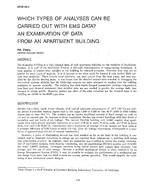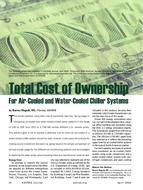System simulation is the representation of an actual system by a modelof analogous characteristics and is used to predict the performance of a system. During the system simulation of a centrifugal chiller, the influence of operating and constructional characteristics on system performance should be taken into account. The simulating model is a two-stage centrifugal chiller using a water-cooled condenser and R-11 as refrigerant. A microcomputer system simulation program containing detailed characteristics was developed. Mathematical equations conceming heat transfer at the evaporator and condenser were introduced, and the evaporating and condensing temperatures can be calculated. Various parameters that affect the overall heat transfer coefficient were analyzed. In the compressor model, the power input is determined according to the isentropic analysis. Compression efficiency is calculated from a compressor map at different load ratios and the entering temperature of condenser water. At a constant water-air ratio and a typical construction of packing fill, the performance of a counterflow induced draft cooling tower was determined from the operating parameters: the load ratio, outdoor wet-bulb temperature, and the number of heat transfer units. Calculated results of the system simulation were verified against the actual measured results.
Citation: ASHRAE Transactions, vol. 95, pt. 1, Chicago 1989
Product Details
- Published:
- 1989
- Number of Pages:
- 10
- File Size:
- 1 file , 1.1 MB
- Product Code(s):
- D-24549


